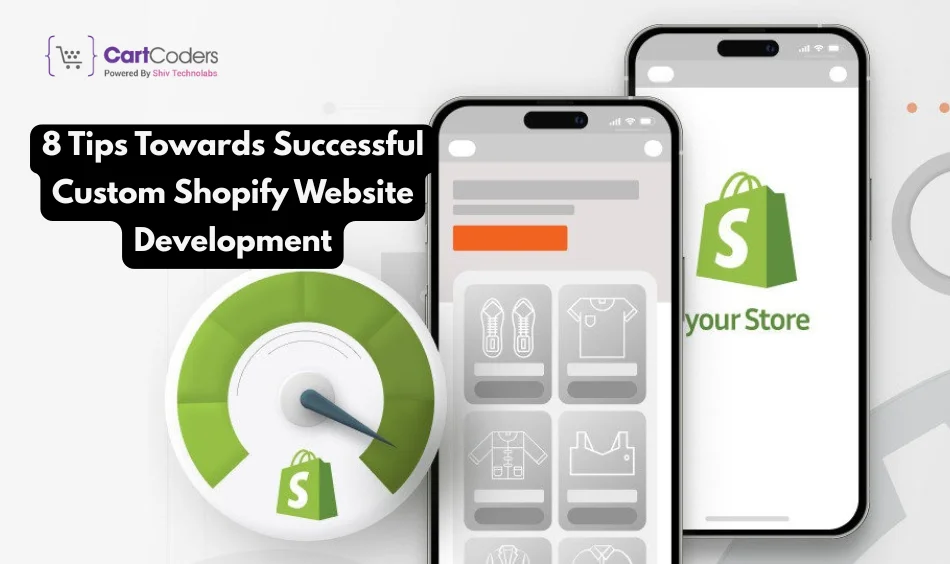Custom Engagement Solutions
Unlock tailored solutions with a free, no-obligation strategy session.
Expert Developers & Engineers on Demand
Scale Your Team with Skilled IT Professionals
Expert Guidance for Digital Transformation

A ready-made theme might help you get a Shopify store up and running, but a custom-built Shopify website can truly reflect your brand’s voice and meet unique business needs.
From layout flexibility to app integration and performance, custom Shopify development gives store owners the freedom to shape their store exactly the way they want. But without a clear strategy, even custom projects can fail to meet expectations.
In this guide, we’ll walk you through why custom development matters and then break down 8 actionable tips that help create a Shopify store that feels professional, performs well, and drives results.
Shopify is known for its simplicity. Thousands of templates are available for anyone to launch a store quickly. But pre-built themes often come with limits—limited features, fixed layouts, and bloated code that may hurt performance.
A custom Shopify website lets you:
Going custom is a great choice for brands that are scaling, have unique selling points, or want full design control.
Now, let’s cover the top 8 tips to make your custom Shopify project a success.

These tips are based on current Shopify standards, trends, and real business needs.
Make sure your store is built on a Shopify 2.0-compatible theme or framework. Online Store 2.0 offers modular sections on all pages, JSON templates, app blocks, and more efficient customizations.
This gives you more control over content and layout without touching too much code every time a change is needed.
Tip: Shopify’s Dawn theme is 2.0-ready and a solid starting point for developers.
More than 70% of Shopify traffic comes from mobile devices. Designing for desktop first is a mistake.
Start your UI planning with mobile screens in mind:
A mobile-friendly site isn’t just a user preference—it directly affects sales.
With Shopify 2.0, you can now add dynamic sections to products, collections, and even static content pages.
This allows for:
It helps tell your product story better and improves on-page engagement.
If you’re on Shopify Plus, you get access to Shopify Functions—a feature that lets developers modify backend logic for discounts, shipping, and payment rules.
You can:
This replaces the need for many third-party apps and reduces code conflicts.
Heavy media can ruin a great UI. Stick to Shopify’s recommended image sizes:
Use tools like TinyPNG, Squoosh, or native Liquid filters to compress images before uploading.
Bonus: Use .webp format for faster loading on supported browsers.
Must Read: Shopify Image Size Guide
If your store has repeating UI blocks—like badges, delivery info, or promotional labels—create custom Liquid snippets.
This approach saves time, reduces code duplication, and makes global changes much easier. One edit reflects across all uses.
Your custom store should be accessible to all. Complying with WCAG 2.1 helps with both user experience and SEO.
Checklist to follow:
Not only does this expand your user base, but it also helps avoid legal issues in certain regions.
Shopify now allows easier handling of custom metafields—additional data fields for products, variants, and more.
You can use metafields to:
They help you enrich your product and collection pages without hardcoding.

At CartCoders, we help you go beyond templates. Whether you’re launching a new brand or scaling an existing one, our custom Shopify website development services are built to support your ideas, design standards, and growth goals.
From custom themes and app integrations to mobile app development, we provide everything you need under one roof.
✅ Pixel-perfect design
✅ Shopify 2.0 and headless support
✅ Fast development and QA
✅ Mobile-friendly performance
Let’s build something your customers will remember.
📞 Contact us today for a quick consultation.
A custom Shopify website isn’t about adding bells and whistles—it’s about building a store that works your way.
When done right, custom development lets you control design, performance, content, and customer experience—all without being stuck in a theme’s limitations.
Follow the 8 tips above to avoid common mistakes and build a store that scales. And if you need expert help, CartCoders is always ready to support your vision with hands-on development and full-cycle support.
Projects delivered in 15+ industries.
95% retention rate, building lasting partnerships.
Serving clients across 25+ countries.
60+ pros | 10+ years of experience.